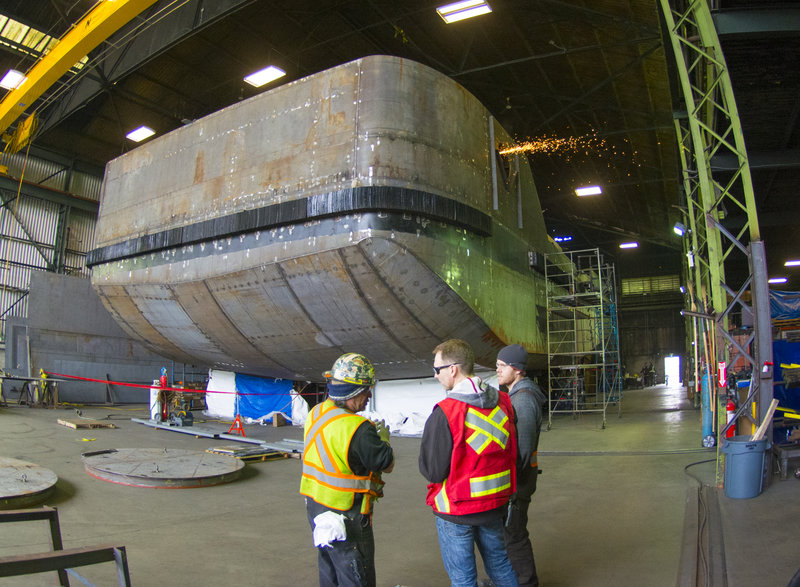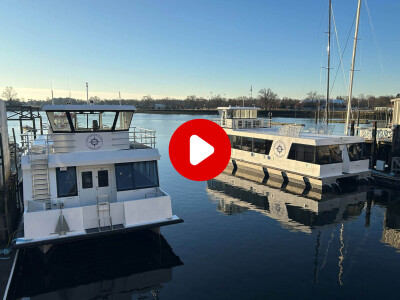Island Tug and Barge (ITB), Vancouver, British Columbia, is building two 24.9m x12.5m (82'x41') tugs that will be paired with two of its existing barges. The two boats, which are under construction at Island Tug and Barge’s Annacis Island Shipyard, are being built with pins for use in an articulated tug and barge (ATB) application. The two existing barges will be modified with the addition of pin ladders and stern extensions for connecting to the new tugs. The Vancouver-based naval architect firm of Robert Allan Ltd. did the design work for the tugs and the barge modifications making extensive use of Computational Fluid Dynamics (CFD).

A rendering of the port bow quarter showing coupling. ITB image
Working with this entirely new design, the shipyard team has the hull and superstructure components of the first tug assembled. As they had the steel cut for the first boat they had the second set cut as well and that, with some assembly, is also in the warehouse along with complete sets of Z-drives, deck cranes and other equipment.
The hull of the first tug dominates one of the warehouses. At the lowest point on the amidships deck the hull has a molded depth of 3.65m (12'). A poop deck aft has flush removal hatches above the two Rolls Royce US105-P9 Z-drives. Forward, a raised forecastle deck contains the port and starboard coupling pins manufactured by the Japanese firm Taisei Engineering Consultants Inc., under the name Articouple.
The main deck house, built, like the hull, in steel, continues aft from the forecastle and will contain accommodations. This includes separate captain and mate cabins with heads, two single bunk crew cabins with shared head and two double bunk crew cabins with shared head. A companion way separates the accommodation area from a fiddly over the engine room that is located below in the hull. The clear deck over the fiddly has removable pads for ease in swapping out engines; it will also support a crane and rescue boat.

One of the Z-drive units ready for installation. Alan Haig Brown photo
The engines, set well aft, are a pair of V-12, IMO Tier II certified, Cummins K38-M diesels each generating 850 hp (634 kW) continuous at 1,800 rpm. The carbon fiber shafts pass through a bulkhead to the port and starboard Z-drive rooms. The Rolls Royce drives, which in March were stored in an adjacent warehouse, have 1,600 m/m (5'3") propellers in nozzles. Forward of the engine room a workshop and tankage makes good use of the ample space. Forward of that, an electric over hydraulic pump for the coupling pins is located just below the main deck pin rooms.
Also in the adjacent warehouse, the aluminum B-deck is taking shape. It will include a wet room, large mess/lounge area and a well laid out galley. Stairs will lead up to a smaller cabin area for the HVAC and wheelhouse electronics. Above that is a large wheelhouse, with full walk around outer deck, and a 12.3-meter (40') height of eye. The aluminum deckhouse and the wheelhouse tower are being fabricated separately for assembly once moved out of the building sheds.
The boats, dedicated ATB vessels with no towing capability, are designed for Island Tug and Barge’s tank barge routes between Vancouver, Vancouver Island and Puget Sound ports, all of which are in relatively sheltered waters.
ITB Marine Group chief fleet engineer, newbuilds, Marinus Goossen expects to have the first boat in the water this coming summer with another month of work alongside prior to sea trials. When a visitor recently commented on the quality of the welding on the steel hull, Goossen, replied with pride, “We are building these boats to Lloyd’s class. All of the welds have been inspected without a single failure,” according to a company press release.




.jpg.small.400x400.jpg)
